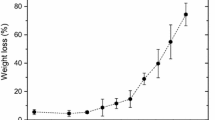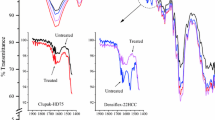Abstract
In this study, headspace gas chromatography/mass spectrometry has been used to assess the volatile by-products generated by the ageing of oil-impregnated paper insulation of power transformers. Sealed-glass ampoules were used to age under oxidative conditions 0.5-g specimens of insulating paper in 9 mL of inhibited mineral oil in a temperature range of 60–120 °C and moisture of 0.5, 1 and 2% (w/w). A linear relationship between one of the oil-soluble degradation by-products, i.e. methanol, and the number of ruptured 1,4-β-glycosidic bonds of cellulose, regardless of the type of paper (ordinary Kraft or thermally-upgraded (TU) Kraft paper), was established for the first time in this field. Ageing at 130 °C of model compounds of the Kraft paper constituents (α-cellulose, hemicellulose and lignin) and two cellulosic breakdown by-products (D-(+)-glucose and 1,6-anhydro-β-d-glucopyranose) confirmed that the α-cellulose degradation was mostly responsible for the presence of this molecule in the system. Furthermore, additional 130 °C-tests with six different papers and pressboard samples under a tight control of initial moisture indicated that at least one molecule of methanol is formed for each rupture of 1,4-β-glucosidic bond of the molecular chains. Stability tests showed that the ageing indicator is stable under the oxygen and temperature conditions of open-breathing transformers. The presence of methanol was detected in 94% of oil samples collected from over than 900 in-service pieces of equipment, confirming the potential for this application. Lastly, the tests have shown that oil-oxidation by-products and TU-nitrogenous agents modify the methanol partitioning coefficients in the paper/oil/air system, which makes their study essential over a range of field conditions encountered by power transformers. Results are presented and discussed in comparison with 2-furfuraldehyde, which is the current reference in the domain.





Similar content being viewed by others
References
Abe K, Maeda T, Shimonaka T, Umemura T (1994) A sensing system for degradation diagnosis of oil-filled transformers. Conference Record of IEEE International Symposium on Electrical Insulation, p 29
Awata M, Mizuno K, Ueda T, Ohta N, Ishii T, Tsukioka H (1997) Diagnosis by acetone for determination of breathing transformers containing an adsorbent in the insulating oil, Trans. IEE Japan 117-B(5):706
Burton PJ, Graham J, Hall AC, Laver JA, Oliver AJ (1984) Recent developments by CEGB to improve the prediction and monitoring of transformer performance. CIGRE Conference Paper 12-09
Burton PJ, Carballeira M, Duval M, Fuller CW, Graham J, de Pablo A, Samat J, Spicar E (1988) Application of liquid chromatography to the analysis of electrical insulating materials, Proc CIGRE Conf, Paris, Paper 15-08
Byrne GA, Gardiner D, Holmes FH (1966) The pyrolysis of cellulose and the action of flame-retardants. J Appl Chem 16:81
Clark FM (1962) Cellulose and liquid impregnated cellulose insulation. In: Insulating materials for design and engineering practice, John Wiley and Sons, Inc., London, p 251
Emsley AM, Stevens GC (1994) Kinetics and mechanisms of the low-temperature degradation of cellulose. Cellulose 1:26–56
Feller RL, Lee SB, Bogaard J (1986) The kinetics of cellulose deterioration. J Adv Chem Ser 212:329
Glassner S, Pierce AR (1965) Gas chromatographic analysis of products from controlled application of heat to paper and levoglucosan. Anal Chem 37:525
Heywood RJ (1997) The degradation models of cellulosic transformer insulation, Ph.D. thesis, University of Surrey, Guilford, Surrey
Jalbert J, Gilbert R, Tétreault P, El Khakani MA (2003) Matrix effects affecting the indirect calibration of the static headspace-gas chromatographic method used for dissolved gas analysis in dielectric liquids. Anal Chem 75(19):5230
Kilzer FJ (1971) Thermal degradation of cellulose. In: Bikales NM, Segal L (eds) High polymers, vol 5, Pt 5, p 1015
Klemm D, Philipp B, Heinze T, Heinze U, Wagenknecht W (1998) Comprehensive cellulose chemistry, vol 1. Wiley-VCH, p 10
Kollmann F and Fengel D (1965) Cited in: Thermal degradation of wood components, U.S.D.A. Forest Service Research Paper FPL 130, U.S. Department of Agriculture, Forest Products Laboratory, Madison, Wisconsin, 1970
Lessard M-C, Lamarre C, Gendron A, Massé M (1995) Determination of paper degradation by-products by direct injection on an HPLC column, Annual Report of CEIDP Conference, Session 4B
Lundgaard LE, Hansen W, Linhjell D, Painter TJ (2004) Aging of oil-impregnated paper in power transformers. IEEE Trans on Power Delivery 19(1):230
Morais RM, Mannheimer WA, Carballeira M, Noualhaguet JC (1999) Furfural analysis for assessing degradation of thermally upgraded papers in transformer insulation. IEEE Trans on Dielectrics and Electrical Insulation 6(2):159
Nelson ML (1960) Apparent activation energy of hydrolysis of some cellulose materials. J of Polymer Sci 18:351
Oommen TV, Petrie EM, Breemen RB, Haney CA (1993) Analysis of furanic compounds from cellulose aging by GC-MS and attempts to correlate with degree of polymerization, CIGRE Berlin Symposium, Paper 110-02
Scheirs J, Camino G, Avidano M, Tumiatti W (1998) Origin of furanic compounds in thermal degradation of cellulosic insulating paper. J Applied Polymer Sci 69:2541
Schroff DH, Stannett AW (1985) A review of paper aging in power transformers. IEE Proc 132(6):312
Schwenker RF, Beck LR (1963) Study of the pyrolytic decomposition of cellulose by gas chromatography. J Polymer Sci Part C 2:331–340
Shafizadeh F (1968) Pyrolysis and combustion of cellulose materials. In: Wolfrom ML, Tipson RS (eds) Advances carbohydrate chemistry, vol 23. Academic press, New York, p 419
Shafizadeh F (1982) Introduction to pyrolysis of biomass. J of Anal Applied Pyrolysis 3:283
Soares S, Ricardo N, Heatley F, Rodrigues E (2001) Low temperature thermal degradation of cellulosic insulating paper in air and transformer oil. Polymer Int 50:303
Tamura R, Anetai H, Ishii T, Kawamura T (1981) Diagnostic of ageing deterioration of insulating paper. JIEE Proc Pub A 101:30
Unsworth J, Mitchell F (1990) Degradation of electrical insulating paper monitored with high performance liquid chromatography. IEEE Trans on Electrical Insulation 25(4):737
Acknowledgements
The authors would like to express their gratitude to M. C. Lessard and B. Noirhomme from IREQ for valuable discussions on this concept. They would also like to thank A. Jolicoeur and P. Gervais from TransÉnergie for supporting the project from the beginning. Finally, a note of appreciation is extended to E. Grenier and M. Dontigny for the initial technical support.
Author information
Authors and Affiliations
Corresponding author
Rights and permissions
About this article
Cite this article
Jalbert, J., Gilbert, R., Tétreault, P. et al. Identification of a chemical indicator of the rupture of 1,4-β-glycosidic bonds of cellulose in an oil-impregnated insulating paper system. Cellulose 14, 295–309 (2007). https://doi.org/10.1007/s10570-007-9124-1
Received:
Accepted:
Published:
Issue Date:
DOI: https://doi.org/10.1007/s10570-007-9124-1




